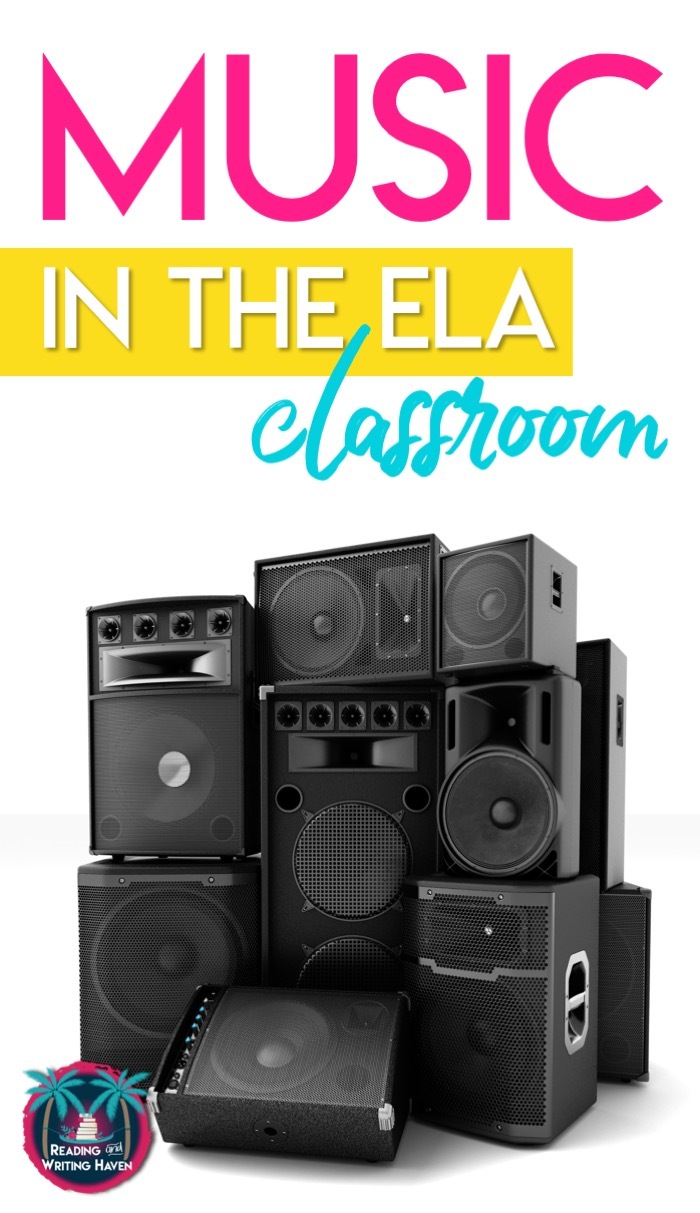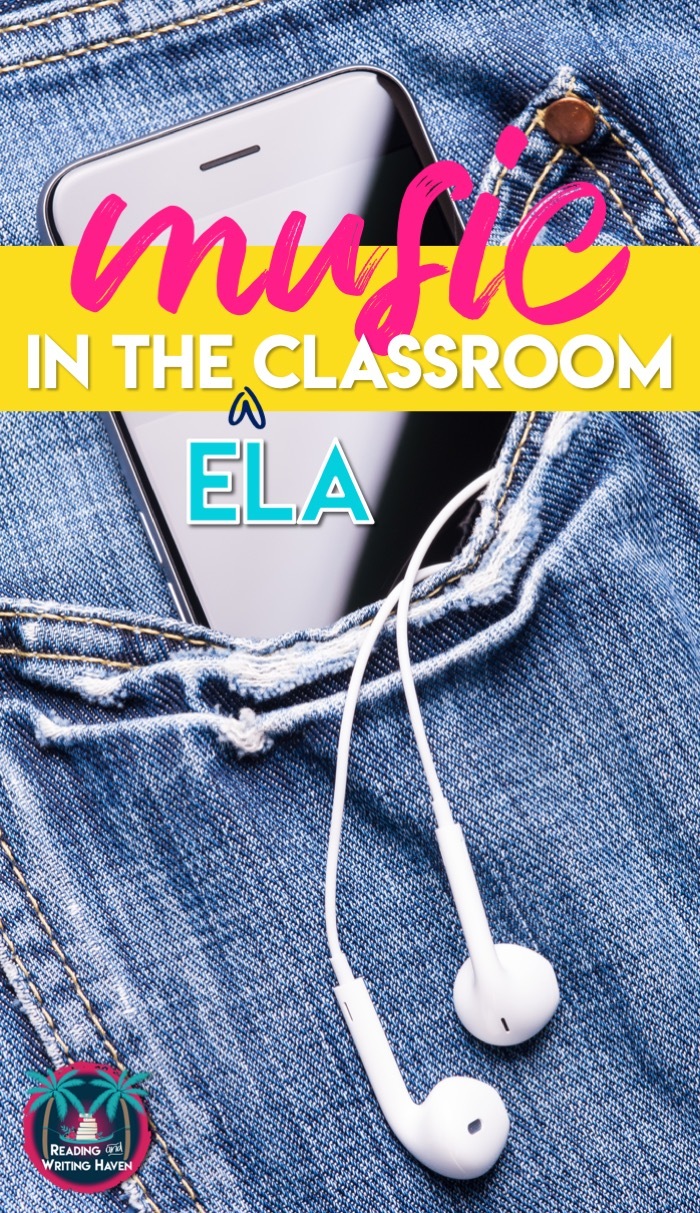Music in the Classroom: 13 Ways to Use Songs in ELA
“After silence, that which comes nearest to expressing the inexpressible is music” (Aldous Huxley). Think about the last time you felt truly inspired. Was music a part of the experience? Music has a way of bringing dull moments to life, putting words to the indescribable, and healing troublesome situations. Considering all of the mental and physical health benefits of music, it only makes sense to use it while teaching. But how? In this post, you’ll find eleven meaningful ways to use music in the classroom.
1. BELL RINGERS
Use music as a bell ringer. Pose a question on the board that relates the song to whatever skill students are currently learning. Songs make for engaging mentor texts. Try “Fly” by Nicki Minaj for parallelism or “Jolene” by Dolly Parton for repetition, figurative language, or characterization.
2. TIMER
We often use timers in the classroom. When students have a few minutes to respond, when you’re transitioning between activities, or when students are cleaning up after an activity, use music! Add some spice to your timers and help students finish tasks on time with songs for a change of pace. A simple way to manage this is to ask students for their favorite *clean song at the beginning of the year. Then, create a playlist (YouTube and Spotify are simple options) so that you can quickly pull it up and select a different tune each time.
3. BRAIN BREAK
Research shows students need brain breaks. Intentionally insert dance breaks or yoga stretches into your lesson plans! You don’t have to play the entire song…just enough to lighten the mood and relieve some stress. Show students how to stretch their forearms and their necks as they relax their minds.
4. FIGURATIVE LANGUAGE
Using music in the classroom is the perfect avenue to reinforce figurative language. Show students the difference between figurative and literal, and help them see how a text’s impact would be lessened without it. “Stereo Hearts”by Gym Class Heroes is excellent for metaphors, “Love Song” by Taylor Swift for allusion, and “Grenade” by Bruno Mars for hyperbole.
5. GRAMMAR
Mix grammar reinforcement into whole-class reviews, small group interventions, or station activities after direct instruction. Playing songs like “Call Me Maybe” by Carly Rae Jepsen can help students to analyze a variety comma rules in an authentic text. Listening to music is just one more way we can give students an opportunity to hear fluent language, which ultimately builds their reading and writing fluency skills.
6. STORY ELEMENTS
When reading literature, we can allow students to analyze how songs relate to the setting, conflicts, character, and theme of the text. Doing so helps them to dig deeper into the story and make connections. How does Alanis Morisette’s “Ironic” echo how Mathilde feels at the end of “The Necklace” or Della and Jim at the end of “The Gift of the Magi”? Or, what is the connection between the themes of Ray Bradbury’s “The Veldt” and St. Vincent’s “Digital Witness”?
7. NARRATIVES
Find songs that have narrative structures, and use them as mentor texts to review story elements before reading or writing fictional works. This behind the scenes look at Disney highlights some of the ways popular songs are intentionally created to impact narrative elements.
8. VOCABULARY
Music in the classroom is fun when paired with vocabulary. Play a clip from a song, and ask students to write a short paragraph or talk with a small group to explain how some of their vocabulary words relate to the lyrics. For instance, while playing “Popular” by Ariana Grande, students might write about words like introspection, insights, epiphany, or renegade. Find a song your students would enjoy, and let them think outside the box to make connections.
9. POETRY
Use music in the classroom to teach poetic elements. After all, it IS poetry! How does the song writer use rhythm, rhyme, and figurative language to enhance the listening experience? Make studying poetry relevant and engaging while asking students to think analytically. Doing so can ease the transition into complex texts. Grab this free handout for any song to get started.
10. MOOD AND TONE
Raise the level of thinking in the room by using songs to teach the concepts of mood and tone. Finding analogies for complex concepts helps to make abstract terms more concrete. Students often get confused with tone and mood. Trying to find ways to help them, I reflected on what has helped me to internalize these concepts. I think of them in terms of music…a sound amplifier. Mood is how I feel while listening, but tone is the author’s voice in the work. I use an equalizer to help students see how the mood and tone fluctuate throughout a song, poem, or other fictional text using this visually appealing activity.
11. MNEMONICS
After visiting the Ron Clark Academy in 2008, I was so encouraged by how teachers use music in the classroom to enhance memory. One of the biggest takeaways I had was finding ways to put ELA concepts to music. On the plane ride home, I spent time finding popular songs and experimenting with replacing the lyrics with words that would help students remember what we were learning.
But, a more effective way to do this is to have students do the work! After modeling an example, put them in small groups or pairs and give them the chorus to a popular song. (They can also pick one themselves if they can do it quickly.) Then, ask them to change the lyrics (but try to keep the same number of syllables to match the music) to words that will help them remember the topic.
12. REFLECTION
Engage students in a meaningful reflection on their year by combining writing, grammar, and music. Students tend to get a little stir-crazy at the end of a semester or year. However, we still want them to be focused and honing their writing skills. One solution I’ve found is to ask them to create a playlist to reflect on a period of time (i.e. – a year, a semester). You can read about the lesson I use in this post, or just grab the activity here!
13. TECHNOLOGY
This year, I’ve been using Garage Band to help students create short pieces to dig deep into thinking. Can students use Live Loops to create a song that echoes the way a character feels? the mood or tone of a text? the plot twists and turns in a narrative? the personality of a character or relationship between two characters? If you don’t have access to Garage Band, there are other apps and online programs you could use instead. Do a quick Google search for free music creation apps, or ask your students for suggestions.
Songs make for high-interest mentor texts that you can use to practice almost any language arts concept or skill. Using music in the classroom is a simple way to engage students, make learning relevant, enhance classroom culture, and raise the energy level in the room. So, try sprinkling it into your lessons!
READ NEXT:
-
11 MEANINGFUL WAYS TO USE THE ARTS IN ELA
-
11 WAYS TO USE COLOR IN ELA CLASS
-
10 ENGAGING LESSONS FOR ELA

